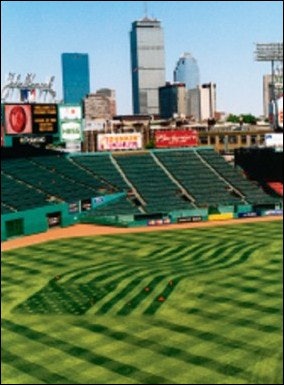Turning game fields into eye-catching works of art takes imagination, practice and a basic knowledge of how bent grass blades reflect light

It was, of all things, a Paul McCartney concert that inspired David Mellor to new heights of personal creativity.
Mellor, a member of the Milwaukee Brewers' grounds crew at the time McCartney's 1993 tour landed on County Stadium's outfield grass with a stage and thousands of spectator seats spanning foul line to foul line, did his best to counteract that June night's deadly combination of heat, rain, plywood and forklifts. With no time to resod before the Brewers' next homestand, Mellor instead tried to camouflage the damaged areas under layers of green sand and grass clippings. It didn't work.
Playable but hardly pleasing to the eye, Mellor's outfield solution took a back seat to Plan B: Mow such an eye-catching design on the infield grass that no one would notice the concert fallout still visible beyond second base. Surrounding the pitcher's mound with a cross-shaped checkerboard pattern laid against a background of alternating light and dark stripes, Mellor produced a hit.
"The feedback was amazing," he says. "Reporters and announcers spoke of that instead of the damage. Colleagues and fans would call and ask, 'Hey, how did you do that?' We realized then that not only could you use patterns at times to hide damage or make imperfections blend in, you could also use something unique to draw attention away from the imperfections."
Over the years since, Mellor's colleagues at the professional, collegiate and even high school levels have become increasingly cognizant of how much a little extra time and creativity can add to the aesthetics of their game fields. Call it the Green Period, if you will, with groundskeepers imagining and implementing new and ever more-complex patterns through which to express their artistry.
Many encores followed for Mellor, now the head groundskeeper for the Boston Red Sox and author of two books on lawn care and turf patterning. He has infused into turfgrass fields such imagery as American flags, player numbers, baseballs and bats, even entire team logos ("I think you can do any logo but a Yankee logo," he quips). Unembittered by the British invasion of his Milwaukee turf more than a decade ago, Mellor embraced a recent Springsteen concert at Fenway Park by etching "Bruce," complete with the home team's trademark "B," in the grass directly in front of the stage.
So, how does he do that. Placing patterns in turf has far less to do with mowing grass blades than with bending them. When bent, grass blades will reflect light in varying ways depending on the viewpoint of the onlooker. Blades bent toward the eye appear dark, since what we see are mostly blade tips and shadows. Blades bent in the opposite direction appear lighter, even shiny, since nearly the entire grass blade is exposed.
The most common and efficient tool used to bend grass is the roller. Most high-end reel mowers like those used by professional sports franchises, college athletic programs, and municipal and private golf courses come equipped with rollers that trail the cutting deck when the mower travels forward, gently bending the freshly cut grass blades in the same direction. However, new patterns can be created or existing ones enhanced with the cutting deck disengaged and only the rollers touching the turf.
An increasing number of manufacturers of lawn and garden tractors are incorporating rollers into their product lines, as corporate groundskeepers and even homeowners have begun to recognize the distinctive look a simple roller - from sand-filled PVC pipes to solid-rubber casters - can lend to their mowing efforts. In 2001, Michigan schoolteacher Bob Greenhoe founded Big League Lawns LLC out of his garage, where he manufactures universal roller kits adaptable to virtually any riding or walkbehind mower, and counts several schools and at least one minor-league baseball franchise among his clients. While Mellor recommends the roller be at least as wide as the cutting deck, Greenhoe suggests that individuals towing his product behind their mowers give themselves a 2- to 4-inch safety margin at each end of the roller, so as not to snag it on a fence, for example.
Mower-mounted rollers can be used to create a variety of straightforward patterns, such as alternating light-and-dark parallel stripes, layered checkerboards and overlapping diamonds, or fan shapes radiating from the pitcher's mound. Curvilinear designs can include waves, spirals and starbursts. Moreover, many of these designs can be created, enhanced or even erased using other common groundskeeping tools, such as hand rollers and drag mats.
More intricate detail work required of team logos or star patterns (an increasingly popular design for fields hosting league all-star games) may necessitate other means to bend select sections of grass. These include water hoses, backpack blowers and rakes. Mellor's first outfield flag, a straight-line version laid out respectfully to scale in the wake of 9/11, inspired several homeowners to create flag patterns in their own lawns. "Two of them had done waves in their flags and used a broom to do their stars. I thought that was amazing," says Mellor, who became every bit as inspired by those who had sent him their photographs. "The team was in town this past Flag Day, so we put a big flag in the outfield with a wave in it and we put the stars in with a broom."
Baseball isn't the only sport that lends itself to mowing-pattern creativity. A soccer field, for example, can easily feature the bull's-eye effect of a spiral radiating from the midfield circle. A field patterned with a broad checkerboard can be further broken down to feature smaller, diagonal checkerboards within the 18-yard boxes at opposite ends of the pitch. (Narrower striping, created with a walk-behind reel or rotary mower, makes small sections of turf appear larger.)
Even American football fields can benefit visually by using mowing patterns, albeit within limits. Fields are typically cut sideline to sideline in parallel fashion, either in one-yard increments with a walk-behind mower, five-yard increments (in which case the space between the 45-yard lines is cut in the same direction so that the end zones likewise match) or 10-yard increments. "The game is played in 10-yard increments, so we mow in 10-yard patterns: 10 yards light, 10 yards dark," says Troy Smith, who mows the fields at the Denver Broncos' practice facility in Englewood, Colo. "That's just our philosophy."
At the NFL level, where even practice fields are marked weekly and mowed at least four times a week, a checkerboard pattern can be created by mowing end zone to end zone prior to painting, then sideline to sideline once the gridiron is laid out in white. The key is to avoid mowing over yard lines, particularly in a perpendicular direction. "If you go over them with the mower one way and come back in another direction, the lines will look like they're painted crooked," Smith says.
The mowing schedule can be even more rigorous in Major League Baseball. Mellor cuts Fenway's 100,000 square feet of turf every day during homestands, a process that can take between 45 minutes and two hours to complete, depending on the pattern. In the interest of time and the turf's health, different parts of a pattern can be incorporated over several days. For example, the infield grass may be cut starting from home plate to third base one day, from home to first the next day (creating a checkerboard) and from home to second the day after that (adding a third layer to the design).
Most groundskeepers agree that two passes over the same pattern produce ideal visual results. "The first one lays the pattern out, but the second one really makes it shine," says Smith. Adds Greenhoe, "It's kind of like Etch-a-Sketch for the grown man. A pattern in a field actually becomes more enhanced the more times you go over it."
But groundskeepers can go overboard. Continually rolling turfgrass in the same direction can adversely affect its growth. "We change our mowing patterns every 10 to 14 days to help with the health of the grass," Mellor says. "You don't want to mow the same way all the time. It not only creates wear areas and compaction, but your grass can actually start growing at an angle."
"The grass blades will start to shade the soil, and you will get a wetter soil," Smith adds. "If you can stand them up, you can get some air in there. You'll find that when you keep doing it in the same direction your grass will tend to become a little lazy, a little less upright."
Can the direction in which grass is bent influence how a batted ball reacts? "It depends on the health of the grass, how much the pattern has been mowed in that direction and how hard the ball is hit," Mellor says. Hard-hit balls won't bounce any differently, he adds, and a rolling ball may be only slightly affected.
According to Mellor, playability really only becomes an issue if groundskeepers are so gung-ho on creating the most elaborate visual impression possible that they lose sight of their field's other needs. "You can spend too much time on that instead of the infield skin, which is most important, or the playability of a football field in terms of the rooting and overall health of the grass," he says. "Patterning is really something to complement all of your hard work in the other areas."
And patterning doesn't have to be hard work, in and of itself. Mellor has used standard art software and scanned templates of different sports fields to create and preview designs on his computer before taking them to the field. Then again, one of his favorite patterns, displayed among several others during a 1996 Canadian Center of Architecture exhibit, was sketched in crayon on a piece of paper by his second-grade daughter, Cacky, in half an hour. The sunburst pattern - squiggly rays emanating in all directions from the pitcher's mound and into the outfield - took Mellor only slightly longer (45 minutes) to implement.
That's with a veteran professional groundskeeper at the mower's controls. What about the novice, for whom mowing a straight path might seem intimidating? Mellor suggests using the field's markings (baselines or sidelines) or a length of string stretched taut between two stakes as a guide. With time, neither should be necessary. "It's like a farmer planting crops; he picks a point in the distance, and he plants toward it," Mellor says. "When mowing a straight line at home, you can pick your neighbor's tree. Here at the park, we'll pick a wall pad or seat and mow toward it." This technique can be assisted by mounting on the mower hood a vertical rod to serve like a gun sight between the groundskeeper in the driver's seat and the predetermined reference point in the distance.
Crooked lines, as Mellor writes in his popular 2001 book Picture Perfect, are easy to mow, but correcting them isn't very difficult, either. (If it's the first line, you simply frame it on both sides; if it appears at the midpoint of a pattern, you return to the last couple of straight lines mowed prior to the error, mow them again and move on until the crooked line is mowed over.)
Mistakes are part of the learning process, and fear of making them shouldn't dissuade groundskeepers at any level from tapping their inner creativity. "With a little trial and error, patterns are only limited by your imagination," Mellor says. "Hopefully, they're done after safety and playability are ensured, but it's an opportunity to make a first impression, whether it's with your team, the visiting team, the fans, TV viewers or school boosters."




































